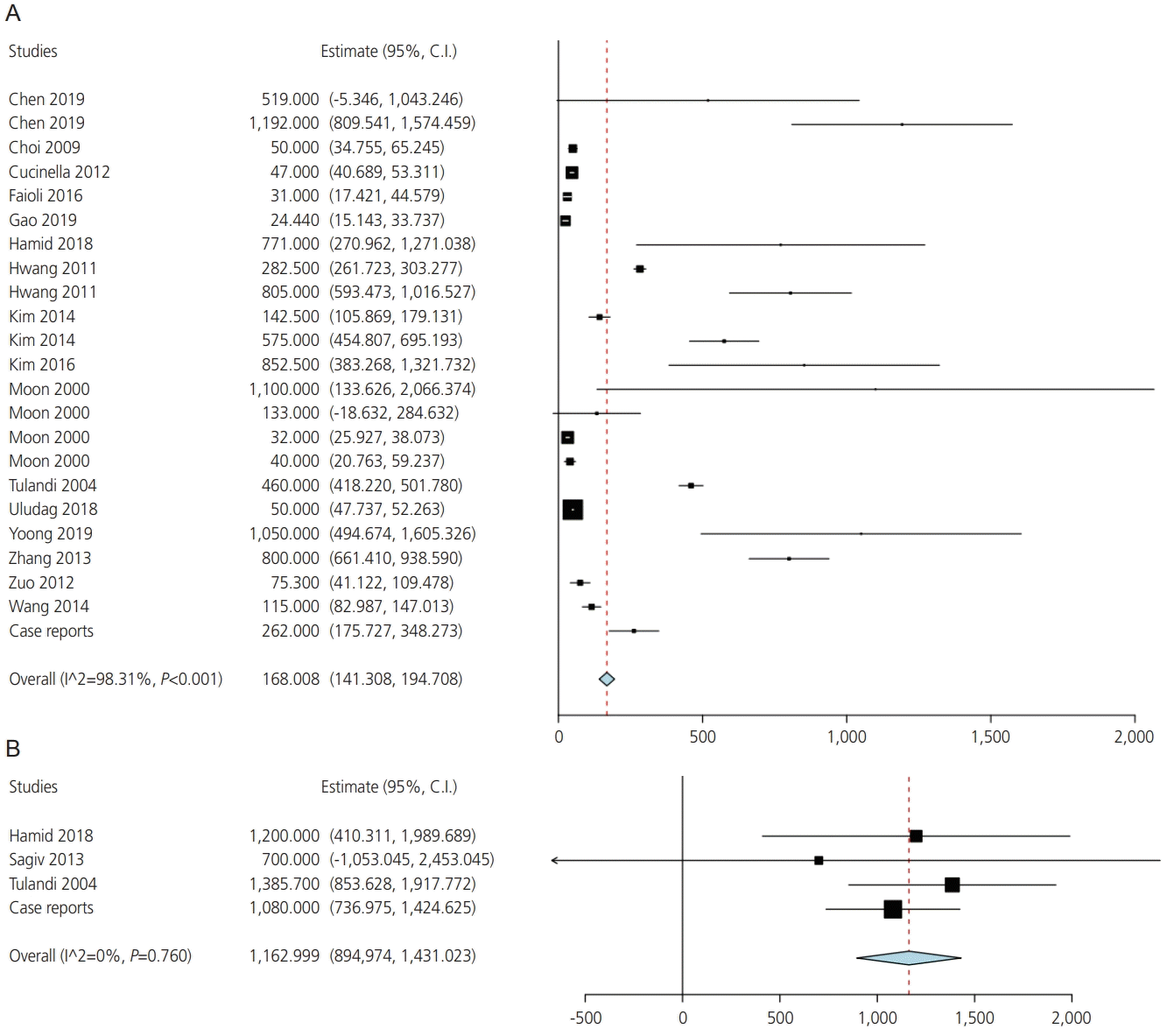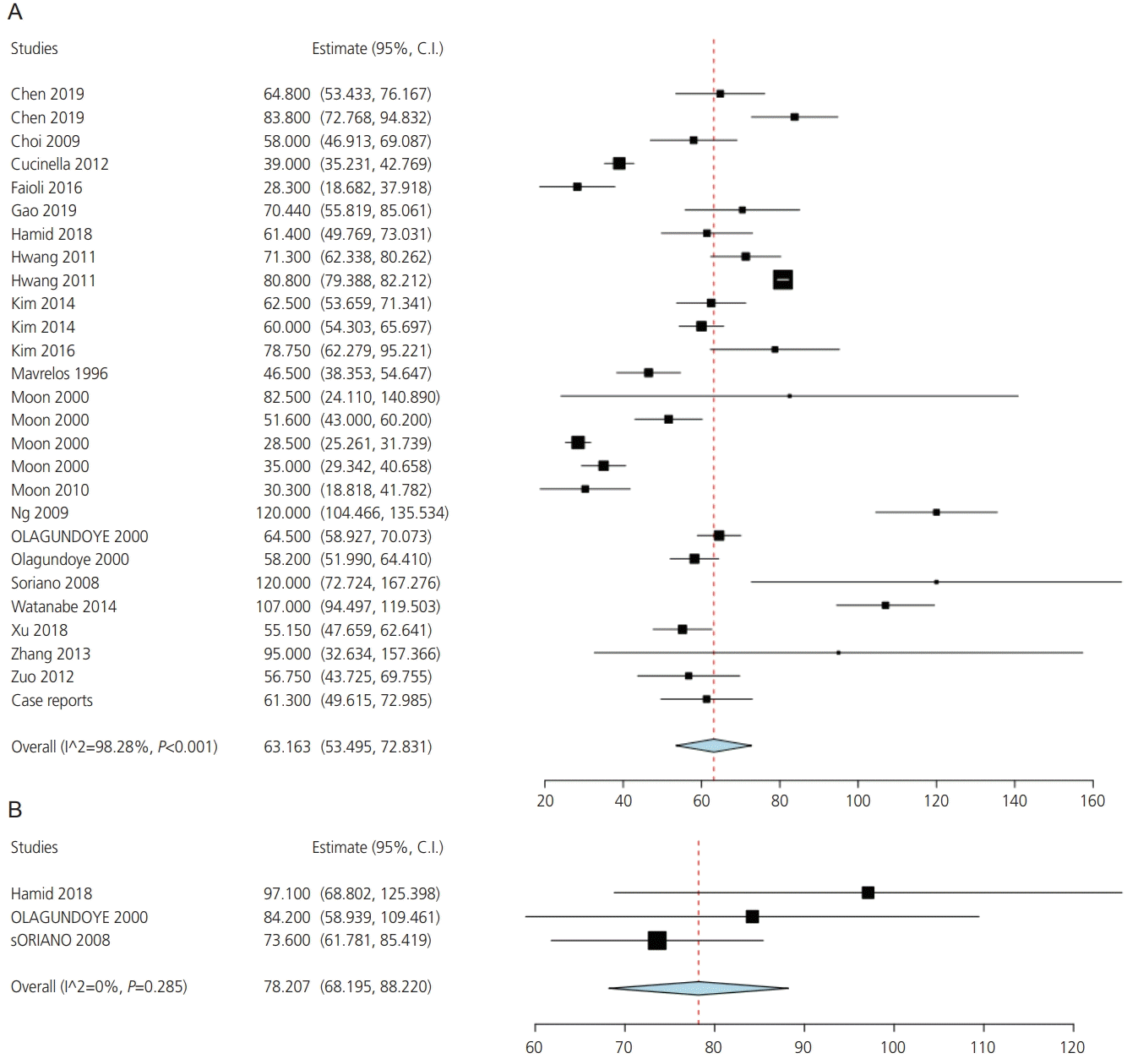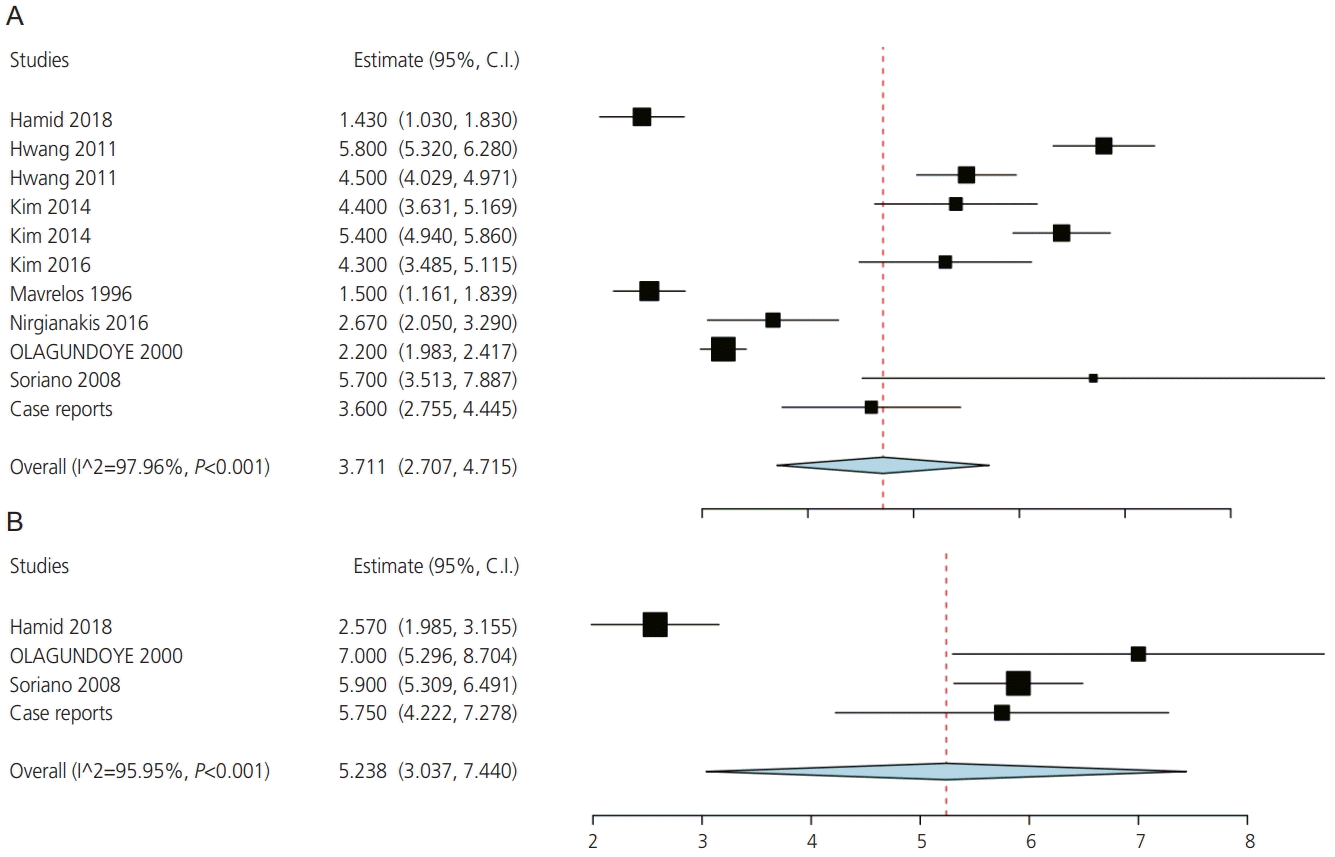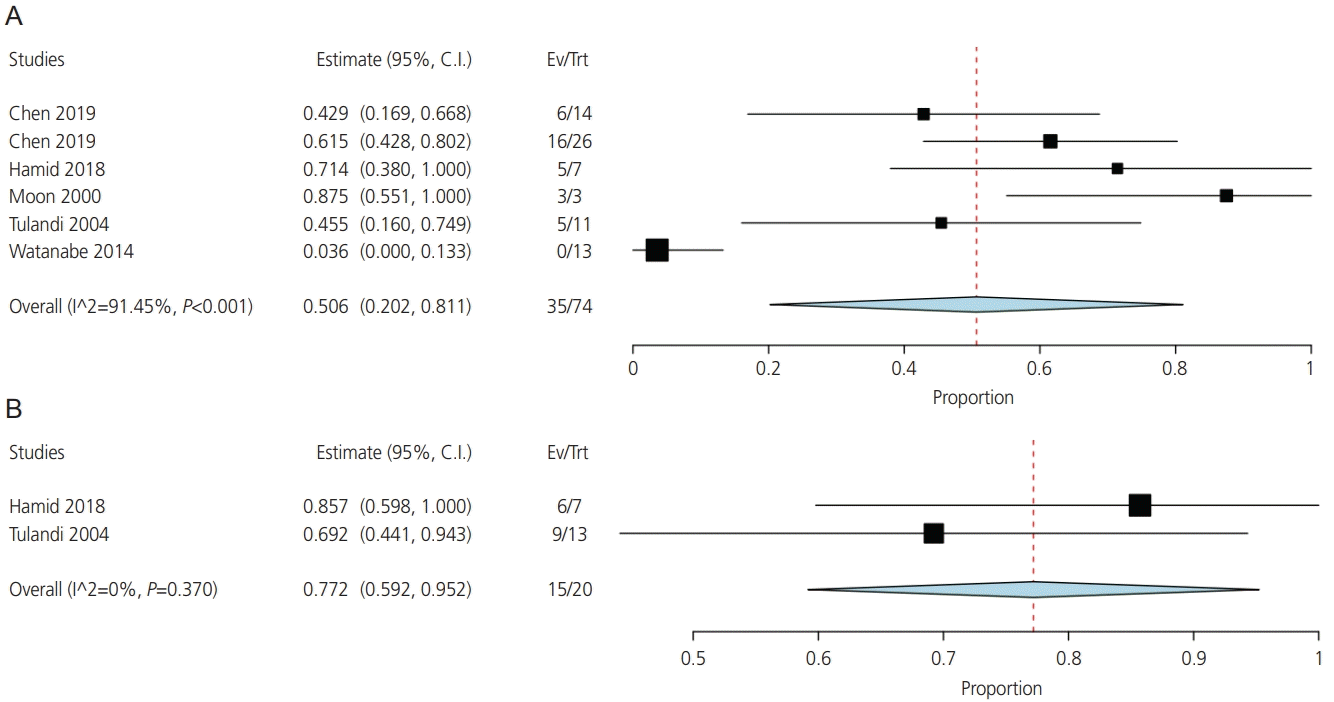1. Jones T, Ho JR, Gualtieri M, Bruno-Gaston J, Chung K, Paulson RJ, et al. Clomiphene stair-step protocol for women with polycystic ovary syndrome. Obstet Gynecol. 2018; 131:91–5.


2. Attar E. Endocrinology of ectopic pregnancy. Obstet Gynecol Clin North Am. 2004; 31:779–94.


3. Stulberg DB, Cain LR, Dahlquist I, Lauderdale DS. Ectopic pregnancy rates and racial disparities in the Medicaid population, 2004-2008. Fertil Steril. 2014; 104:1671–6.

4. Ghaneie A, Grajo JR, Derr C, Kumm TR. Unusual ectopic pregnancies: sonographic findings and implications for management. J Ultrasound Med. 2015; 34:951–62.

5. Habana A, Dokras A, Giraldo JL, Jones EE. Cornual heterotopic pregnancy: contemporary management options. Am J Obstet Gynecol. 2000; 182:1264–70.


6. Soriano D, Vicus D, Mashiach R, Schiff E, Seidman D, Goldenberg M. Laparoscopic treatment of cornual pregnancy: a series of 20 consecutive cases. Fertil Steril. 2008; 90:839–43.


7. Faraj R, Steel M. Management of cornual (interstitial) pregnancy. Obstet Gynaecol. 2007; 9:249–55.

8. Lau S, Tulandi T. Conservative medical and surgical management of interstitial ectopic pregnancy. Fertil Steril. 1999; 72:207–15.


9. Moawad NS, Mahajan ST, Moniz MH, Taylor SE, Hurd WW. Current diagnosis and treatment of interstitial pregnancy. Am J Obstet Gynecol. 2010; 202:15–29.

10. Levine DJ. Safety and efficacy of laparoscopy for benign gynecologic conditions. Am J Obstet Gynecol. 2001; 184:1585–6.


11. Tadir Y, Fisch B. Operative laparoscopy: a challenge for general gynecology? Am J Obstet Gynecol. 1993; 169:7–12.


12. Gyr T, Ghezzi F, Arslanagic S, Leidi L, Pastorelli G, Franchi M. Minimal invasive laparoscopic hysterectomy with ultrasonic scalpel. Am J Surg. 2001; 181:516–9.


13. Sulewski JM, Curcio FD, Bronitsky C, Stenger VG. The treatment of endometriosis at laparoscopy for infertility. Am J Obstet Gynecol. 1980; 138:128–32.


15. Higgins JP, Thomas J, Chandler J, Cumpston M, Li T, Page MJ, et al. Cochrane handbook for systematic reviews of interventions. 2nd ed. Chichester: John Wiley & Sons, Ltd;2008.
16. Moher D, Liberati A, Tetzlaff J, Altman DG; PRISMA Group. Preferred reporting items for systematic reviews and meta-analyses: The PRISMA statement. PLoS Med. 2009; 6:e1000097.

21. Divry V, Hadj S, Bordes A, Genod A, Salle B. Case of progressive intrauterine twin pregnancy after surgical treatment of cornual pregnancy. Fertil Steril. 2007; 87:190.e1–3.

22. Dumesic DA, Damario MA, Session DR. Interstitial heterotopic pregnancy in a woman conceiving by in vitro fertilization after bilateral salpingectomy. Mayo Clin Proc. 2001; 76:90–2.


23. Garretto D, Lee LN, Budorick NE, Figueroa R. Interstitial twin pregnancy: a unique case presentation. J Clin Ultrasound. 2015; 43:447–50.


24. Garzon S, Laganà AS, Pomini P, Raffaelli R, Ghezzi F, Franchi M. Laparoscopic reversible occlusion of uterine arteries and cornuostomy for advanced interstitial pregnancy. Minim Invasive Ther Allied Technol. 2019; 28:359–62.


25. Gezer A, Mutlu H. Laparoscopic management of cornual pregnancy without sutures. Arch Gynecol Obstet. 2004; 270:194–6.


26. Grimbizis GF, Tsalikis T, Mikos T, Zepiridis L, Athanasiadis A, Tarlatzis BC, et al. Case report: laparoscopic treatment of a ruptured interstitial pregnancy. Reprod Biomed Online. 2004; 9:447–51.


27. Grobman WA, Milad MP. Conservative laparoscopic management of a large cornual ectopic pregnancy. Hum Reprod. 1998; 13:2002–4.


28. Kalchman GG, Meltzer RM. Interstitial pregnancy following homolateral salpingectomy. Report of 2 cases and a review of the literature. Am J Obstet Gynecol. 1966; 96:1139–43.

29. Kasum M, Grizelj V, Simunic V. Combined interstitial and intrauterine pregnancies after in-vitro fertilization and embryo transfer. Hum Reprod. 1998; 13:1547–9.


30. Ko ML, Jeng CJ, Chou CS, She BC, Chen SC, Tzeng CR. Laparoscopic electrodessication of an interstitial pregnancy. Fertil Steril. 2007; 88:705.e19–20.

31. Koukoura O, Dragoumis G, Gorila G, Gkorezi-Ntavela I, Dafopoulos K, Pistofidis G. Spontaneous intraoperative rupture of a large interstitial pregnancy: laparoscopic management. Case Rep Obstet Gynecol. 2020; Apr. 14. [Epub].
https://doi.org/10.1155/2020/5626783.

32. Kumakiri J, Takeuchi H, Kitade M, Kikuchi I, Shimanuki H, Kubo M, et al. Interstitial pregnancy with huge adenomyosis uteri managed laparoscopically by using pre-operative and intra-operative imaging: case report. BJOG. 2005; 112:1578–80.


33. Lai YJ, Lin CH, Hou WC, Hwang KS, Yu MH, Su HY. Pregnancy in a noncommunicating rudimentary horn of a unicornuate uterus: prerupture diagnosis and management. Taiwan J Obstet Gynecol. 2016; 55:604–6.


34. Lam PM, Lok IH, Yip SK. Two cases of heterotopic cornual pregnancy with initially missed diagnosis. Aust N Z J Obstet Gynaecol. 2004; 44:256–9.


35. Lee ES, Hahn HS, Park BJ, Ro DY, Kim JH, Kim YW. Single-port laparoscopic cornual resection for a spontaneous cornual ectopic pregnancy following ipsilateral salpingectomy. Fertil Steril. 2011; 96:e106–10.

36. Lialios GA, Kallitsaris A, Kabisios T, Messinis IE. Ruptured heterotopic interstitial pregnancy: rare case of acute abdomen in a Jehovah’s Witness patient. Fertil Steril. 2008; 90:1200.e15–7.

37. Liao CY, Ding DC. Repair of uterine rupture in twin gestation after laparoscopic cornual resection. J Minim Invasive Gynecol. 2009; 16:493–5.


38. Maher PJ, Grimwade JC. Cornual pregnancy--diagnosis before rupture a report of 2 cases. Aust N Z J Obstet Gynaecol. 1982; 22:172–4.

39. Marfori CQ, Kotzen M. Angular vs. interstitial pregnancy: a case report highlighting diagnostic nuances with stark management differences. Case Rep Womens Health. 2018; 19:e00068.

40. Morita Y, Tsutsumi O, Momoeda M, Taketani Y. Cornual pregnancy successfully treated laparoscopically with fibrin glue hemostasis. Obstet Gynecol. 1997; 90(4 Pt 2):685–7.

41. Nabeshima H, Nishimoto M, Utsunomiya H, Arai M, Ugajin T, Terada Y, et al. Total laparoscopic conservative surgery for an intramural ectopic pregnancy. Diagn Ther Endosc. 2010; Oct. 11. [Epub].
https://doi.org/10.1155/2010/504062.

42. Oelsner G, Admon D, Shalev E, Shalev Y, Kukia E, Mashiach S. A new approach for the treatment of interstitial pregnancy. Fertil Steril. 1993; 59:924–5.


43. Oral S, Akpak YK, Karaca N, Babacan A, Savan K. Cornual heterotopic pregnancy after bilateral salpingectomy and uterine septum resection resulting in term delivery of a healthy infant. Case Rep Obstet Gynecol. 2014; Nov. 5. [Epub].
https://doi.org/10.1155/2014/157030.

44. Osuga Y, Tsutsumi O, Fujiwara T, Kugu K, Fujimoto A, Taketani Y. Usefulness of long-jaw forceps in laparoscopic cornual resection of interstitial pregnancies. J Am Assoc Gynecol Laparosc. 2001; 8:429–32.


45. Pasic RP, Hammons G, Gardner JS, Hainer M. Laparoscopic treatment of cornual heterotopic pregnancy. J Am Assoc Gynecol Laparosc. 2002; 9:372–5.


47. Pluchino N, Ninni F, Angioni S, Carmignani A, Genazzani AR, Cela V. Spontaneous cornual pregnancy after homolateral salpingectomy for an earlier tubal pregnancy: a case report and literature review. J Minim Invasive Gynecol. 2009; 16:208–11.


50. Ron-el R, Langer R, Herman A, Caspi E, Bukovsky Y. Term delivery following mid‐trimester ruptured cornual pregnancy with combined intrauterine pregnancy. Case report. Br J Obstet Gynaecol. 1988; 95:619–20.


51. Sagiv R, Golan A, Arbel-Alon S, Glezerman M. Three conservative approaches to treatment of interstitial pregnancy. J Am Assoc Gynecol Laparosc. 2001; 8:154–8.


52. Rheinboldt M, Ibrahim S. Atypical presentation of a large interstitial pregnancy. Emerg Radiol. 2013; 20:251–4.


53. Raheem M, Afifi Y. Laparoscopic selective ipsilateral uterine artery ligation for the management of a cornual ectopic pregnancy. J Minim Invasive Gynecol. 2008; 15:260–1.


54. Quinlan D, Newcombe M. Cornual ectopic pregnancy. J Obstet Gynaecol Can. 2007; 29:537–8.


55. Ross R, Lindheim SR, Olive DL, Pritts EA. Cornual gestation: a systematic literature review and two case reports of a novel treatment regimen. J Minim Invasive Gynecol. 2006; 13:74–8.


56. Sahoo S, Jose J, Shah N, Opemuyi I. Recurrent cornual ectopic pregnancies. Gynecol Surg. 2009; 6:389–91.

58. Sarmini RO, Tate D. Ruptured left cornual gestation in an unstable patient. J Minim Invasive Gynecol. 2005; 12:383.


59. Sherer DM, Scibetta JJ, Sanko SR. Heterotopic quadruplet gestation with laparoscopic resection of ruptured interstitial pregnancy and subsequent successful outcome of triplets. Am J Obstet Gynecol. 1995; 172:216–7.


60. Takeda A, Koyama K, Imoto S, Mori M, Sakai K, Nakamura H. Successful management of interstitial pregnancy with fetal cardiac activity by laparoscopicassisted cornual resection with preoperative transcatheter uterine artery embolization. Arch Gynecol Obstet. 2009; 280:305–8.


61. Tinelli A, Malvasi A, Pellegrino M, Pontrelli G, Martulli B, Tsin DA. Laparoscopical management of cornual pregnancies: a report of three cases. Eur J Obstet Gynecol Reprod Biol. 2010; 151:199–202.

62. Ugwumadu AHN, Hamid R, Ross LD. Live infant salvaged from a ruptured cornual (interstitial) pregnancy at 33-weeks gestation. Int J Gynecol Obstet. 1997; 58:247–9.

63. Vicino M, Loverro G, Resta L, Bettocchi S, Vimercati A, Selvaggi L. Laparoscopic cornual excision in a viable large interstitial pregnancy without blood flow detected by color Doppler ultrasonography. Fertil Steril. 2000; 74:407–9.


64. Vilos GA. Laparoscopic resection of a heterotopic cornual pregnancy followed by term vaginal delivery. J Am Assoc Gynecol Laparosc. 1995; 2:471–3.


65. Vilos GA. Laparoscopic ligation and resection of two ipsilateral interstitial pregnancies in the same patient. J Am Assoc Gynecol Laparosc. 2001; 8:299–302.


66. Chopra S, Keepanasseril A, Rohilla M, Bagga R, Kalra J, Jain V. Obstetric morbidity and the diagnostic dilemma in pregnancy in rudimentary horn: retrospective analysis. Arch Gynecol Obstet. 2009; 280:907–10.


67. Weissman A, Fishman A. Uterine rupture following conservative surgery for interstitial pregnancy. Eur J Obstet Gynecol Reprod Biol. 1992; 44:237–9.


68. Wood C, Hurley V. Ultrasound diagnosis and laparoscopic excision of an interstitial ectopic pregnancy. Aust N Z J Obstet Gynaecol. 1992; 32:371–2.

69. Woodland MB, DePasquale SE, Molinari JA, Sagullo CC. Laparoscopic approach to interstitial pregnancy. J Am Assoc Gynecol Laparosc. 1996; 3:439–41.


71. Yang H, Song T. Temporary simultaneous 2 arterial occlusions during laparoscopic management for cornual ectopic pregnancy. J Minim Invasive Gynecol. 2018; 25:961–2.


72. Zhang X, Liu X, Fan H. Interstitial pregnancy and transcervical curettage. Obstet Gynecol. 2004; 104(5 Pt 2):1193–5.


73. Zhang K, Yuan P. Laparoscopy-assisted vaginal cornual resection for the treatment of large interstitial pregnancy. J Laparoendosc Adv Surg Tech A. 2013; 23:783–6.


74. Api M, Api O. Laparoscopic cornuotomy in the management of an advanced interstitial ectopic pregnancy: a case report. Gynecol Endocrinol. 2010; 26:208–2.


75. Attia M, Karuppaswamy J, Griffith H. Management of interstitial (cornual) pregnancy at 17 weeks’ gestation: conservation of a ruptured uterus. J Obstet Gynaecol. 2005; 25:722–3.


76. Bremner T, Cela V, Luciano AA. Surgical management of interstitial pregnancy. J Am Assoc Gynecol Laparosc. 2000; 7:387–9.


77. Cai Z, Wang F, Cao H, Xia Q. Transcervical suction of interstitial pregnancy under laparoscopic and hysteroscopic guidance. J Minim Invasive Gynecol. 2009; 16:761–4.

78. Casadio P, Formelli G, Spagnolo E, De Angelis D, Marra E, Armillotta F, et al. Laparoscopic treatment of interstitial twin pregnancy. Fertil Steril. 2009; 92:390.e13–7.

79. Chachan S, Waters N, Kent A. Laparoscopic management of cornual heterotopic pregnancy with the use of Harmonic ACE®-a case report. Gynecol Surg. 2011; 8:243–6.

80. Chauhan M, Chaudhary P, Dahiya P, Sangwan K, Sen J. Molar cornual ectopic pregnancy. Acta Obstet Gynecol Scand. 2006; 85:625–6.


81. Cheng Z, Xu L, Zhu Y, Dai H, Qu X, Gong J. Laparoscopic uterine vessels occlusion for the treatment of interstitial pregnancy. J Laparoendosc Adv Surg Tech A. 2009; 19:509–12.


82. Chin HY, Chen FP, Wang CJ, Shui LT, Liu YH, Soong YK. Heterotopic pregnancy after in vitro fertilizationembryo transfer. Int J Gynecol Obstet. 2004; 86:411–6.

83. Corić M, Barisić D, Strelec M. Laparoscopic approach to interstitial pregnancy. Arch Gynecol Obstet. 2004; 270:287–9.


85. Di Tizio L, Spina MR, Gustapane S, D’Antonio F, Liberati M. Interstitial pregnancy: from medical to surgical approach-report of three cases. Case Rep Obstet Gynecol. 2018; Oct. 15. [Epub].
https://doi.org/10.1155/2018/2815871.

86. Cucinella G, Rotolo S, Calagna G, Granese R, Agrusa A, Perino A. Laparoscopic management of interstitial pregnancy: the “purse-string” technique. Acta Obstet Gynecol Scand. 2012; 91:996–9.


87. Zuo X, Shen A, Chen M. Successful management of unruptured interstitial pregnancy in 17 consecutive cases by using laparoscopic surgery. Aust N Z J Obstet Gynaecol. 2012; 52:387–90.


88. Gao B, Cheng C, Pan Q, Johnson G, Qin X, Xu D. Laparoscopic strategy for heterotopic interstitial pregnancy following assisted reproductive techniques. JSLS. 2019; Apr-Jun. [Epub].
https://doi.org/10.4293/JSLS.2018.00109.

89. MacRae R, Olowu O, Rizzuto MI, Odejinmi F. Diagnosis and laparoscopic management of 11 consecutive cases of cornual ectopic pregnancy. Arch Gynecol Obstet. 2009; 280:59–64.


90. Tulandi T, Al-Jaroudi D. Interstitial pregnancy: results generated from the society of reproductive surgeons registry. Obstet Gynecol. 2004; 103:47–50.


91. Watanabe T, Watanabe Z, Watanabe T, Fujimoto K, Sasaki E. Laparoscopic cornuotomy for interstitial pregnancy and postoperative course. J Obstet Gynaecol Res. 2014; 40:1983–8.


92. Uludag SZ, Kutuk MS, Dolanbay M, Ozgun MT, Eliyeva G, Altun O. Conservative management of interstitial pregnancies: experience of a single centre. J Obstet Gynaecol. 2018; 38:848–53.


93. Sagiv R, Debby A, Keidar R, Kerner R, Golan A. Interstitial pregnancy management and subsequent pregnancy outcome. Acta Obstet Gynecol Scand. 2013; 92:1327–30.


94. Chen PL, Lin HH, Hsiao SM. Predictors of subsequent pregnancy in women who underwent laparoscopic cornuostomy or laparoscopic wedge resection for interstitial pregnancy. J Chin Med Assoc. 2019; 82:138–42.


95. Xu W, Lin X, Huang D, Zhang S. Laparoscopic treatment of cornual heterotopic pregnancy: a retrospective cohort study. Int J Surg. 2018; 53:98–102.


96. Choi YS, Eun DS, Choi J, Shin KS, Choi JH, Park HD. Laparoscopic cornuotomy using a temporary tourniquet suture and diluted vasopressin injection in interstitial pregnancy. Fertil Steril. 2009; 91:1933–7.

97. Olagundoye V, Adeghe J, Guirguis M, Cox C, Murphy D. Laparoscopic surgical management of ectopic pregnancy: a district general hospital experience. J Obstet Gynaecol. 2000; 20:620–3.
98. Ng S, Hamontri S, Chua I, Chern B, Siow A. Laparoscopic management of 53 cases of cornual ectopic pregnancy. Fertil Steril. 2009; 92:448–52.


99. Wang YL, Weng SS, Huang WC, Su TH. Laparoscopic management of ectopic pregnancies in unusual locations. Taiwan J Obstet Gynecol. 2014; 53:466–70.


100. Grant A, Murji A, Atri M. Can the presence of a surrounding endometrium differentiate eccentrically located intrauterine pregnancy from interstitial ectopic pregnancy? J Obstet Gynaecol Can. 2017; 39:627–34.


101. Kim MJ, Jung YW, Cha JH, Seok HH, Han JE, Seong SJ, et al. Successful management of heterotopic cornual pregnancy with laparoscopic cornual resection. Eur J Obstet Gynecol Reprod Biol. 2016; 203:199–203.


102. Mencaglia L, Tiso E, Tantini C, Bianchi R. Risks of virus transmission during diagnostic hysteroscopy. J Am Assoc Gynecol Laparosc. 1996; 3(4, Supplement):S30.

103. Moon HS, Choi YJ, Park YH, Kim SG. New simple endoscopic operations for interstitial pregnancies. Am J Obstet Gynecol. 2000; 182:114–21.


104. Moon HS, Kim SG, Park GS, Choi JK, Koo JS, Joo BS. Efficacy of bleeding control using a large amount of highly diluted vasopressin in laparoscopic treatment for interstitial pregnancy. Am J Obstet Gynecol. 2010; 203:30e1–6.


105. Nirgianakis K, Papadia A, Grandi G, McKinnon B, Bolla D, Mueller MD. Laparoscopic management of ectopic pregnancies: a comparison between interstitial and “more distal” tubal pregnancies. Arch Gynecol Obstet. 2017; 295:95–101.


107. Lazard A, Poizac S, Courbiere B, Cravello L, Gamerre M, Agostini A. Cornual resection for interstitial pregnancy by laparoendoscopic single-site surgery. Fertil Steril. 2011; 95:2432e5–8.

108. Huang MC, Su TH, Lee MY. Laparoscopic management of interstitial pregnancy. Int J Gynaecol Obstet. 2005; 88:51–2.


109. Yoong W, Neophytou C, de Silva L, Adeyemo A, Lodhi W. Novel laparoscopic cornual resection of interstitial pregnancy using the Endo GIATM Universal Stapler (Medtronic): a series of 12 cases. Aust N Z J Obstet Gynaecol. 2020; 60:130–4.

112. Faioli R, Berretta R, Dall’Asta A, Di Serio M, Galli L, Monica M, et al. Endoloop technique for laparoscopic cornuectomy: a safe and effective approach for the treatment of interstitial pregnancy. J Obstet Gynaecol Res. 2016; 42:1034–7.


113. Hwang JH, Lee JK, Lee NW, Lee KW. Open cornual resection versus laparoscopic cornual resection in patients with interstitial ectopic pregnancies. Eur J Obstet Gynecol Reprod Biol. 2011; 156:78–82.

114. Kim MK, Kim JJ, Choi JS, Eom JM, Lee JH. Prospective comparison of single port versus conventional laparoscopic surgery for ectopic pregnancy. J Obstet Gynaecol Res. 2015; 41:590–5.


115. Cucinella G, Calagna G, Rotolo S, Granese R, Saitta S, Tonni G, et al. Interstitial pregnancy: a ‘road map’ of surgical treatment based on a systematic review of the literature. Gynecol Obstet Invest. 2014; 78:141–9.


116. Gao M, Gao Q, Jia J, Bao L, Zhang P, Tian JH, et al. Laparoscopy versus laparotomy for ectopic pregnancy: a systematic review. Chinese Journal of Evidence-Based Medicine. 2009; 9:994–1000.
117. Ehrenberg-Buchner S, Sandadi S, Moawad NS, Pinkerton JS, Hurd WW. Ectopic pregnancy: role of laparoscopic treatment. Clin Obstet Gynecol. 2009; 52:372–9.

118. Rempen A, Dietl J. Complication rates after surgical treatment of ectopic pregnancy. Hum Reprod. 1999; 14:1401–3.






 PDF
PDF Citation
Citation Print
Print







 XML Download
XML Download